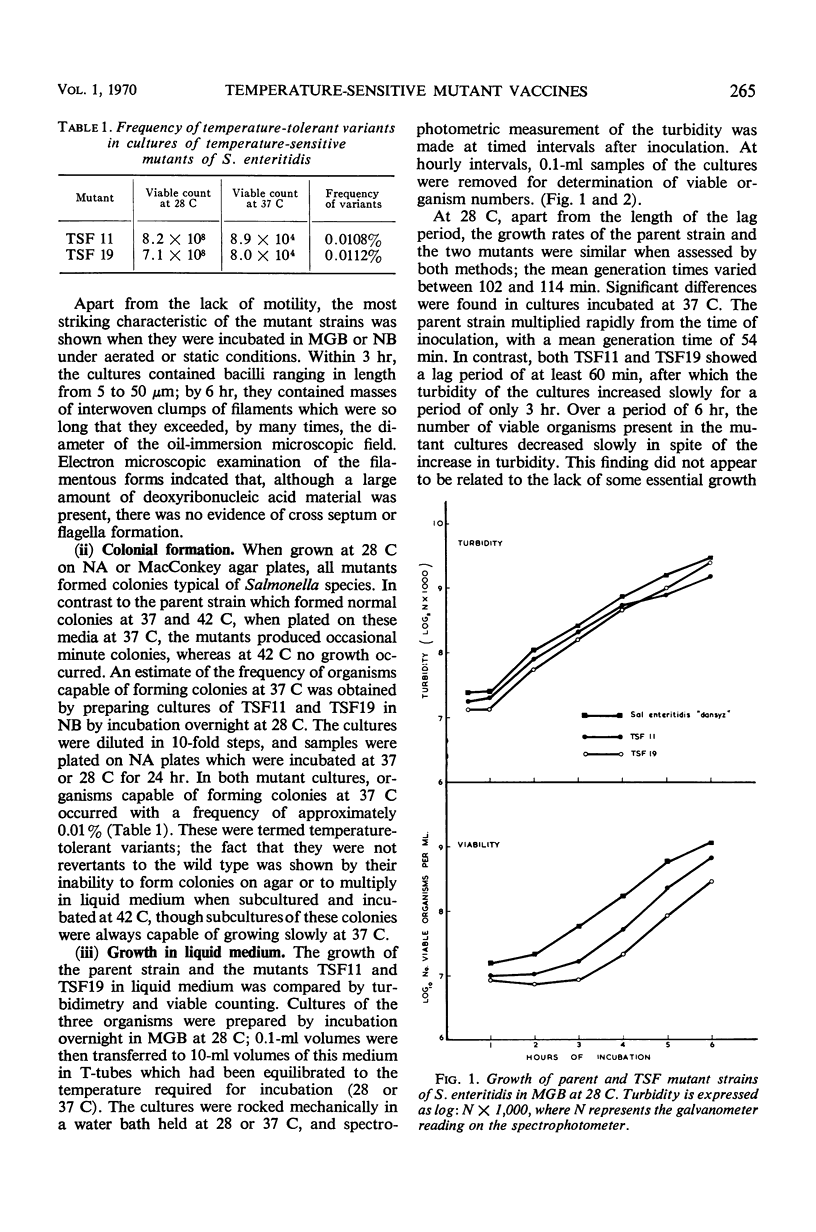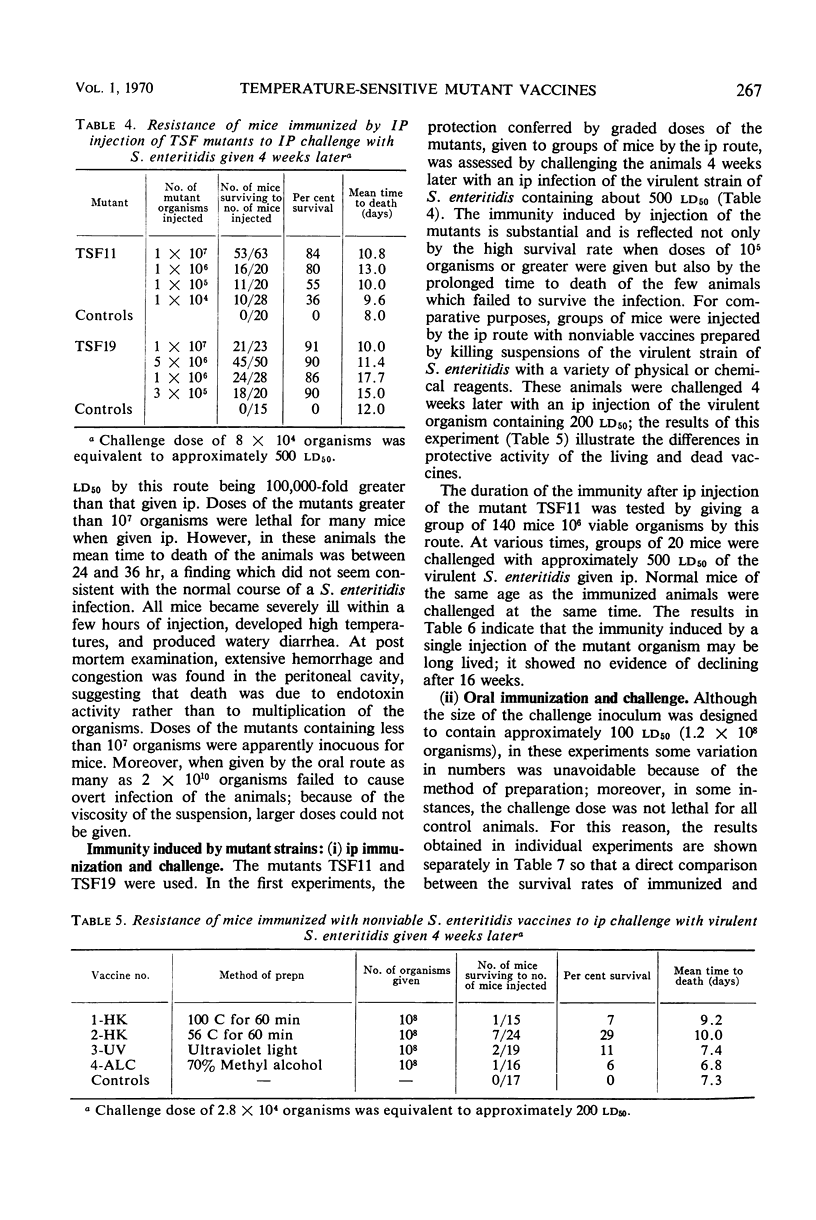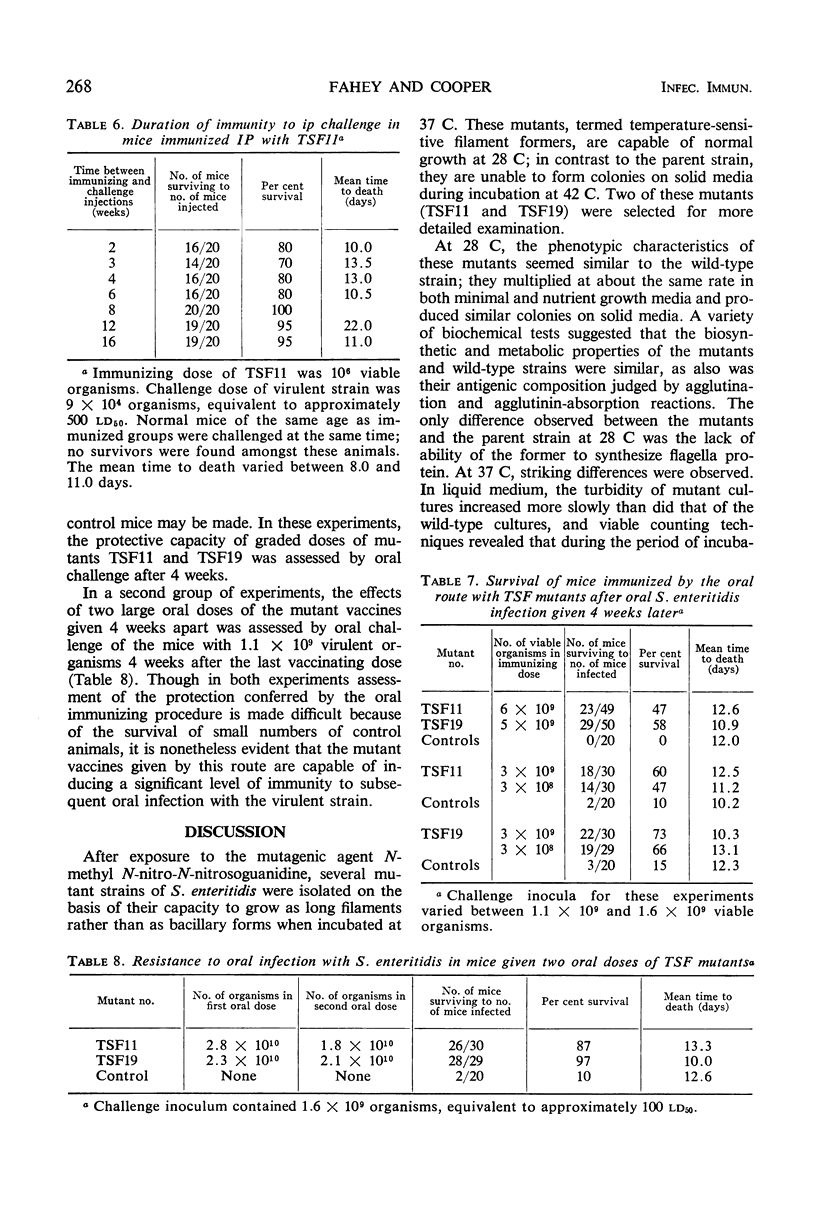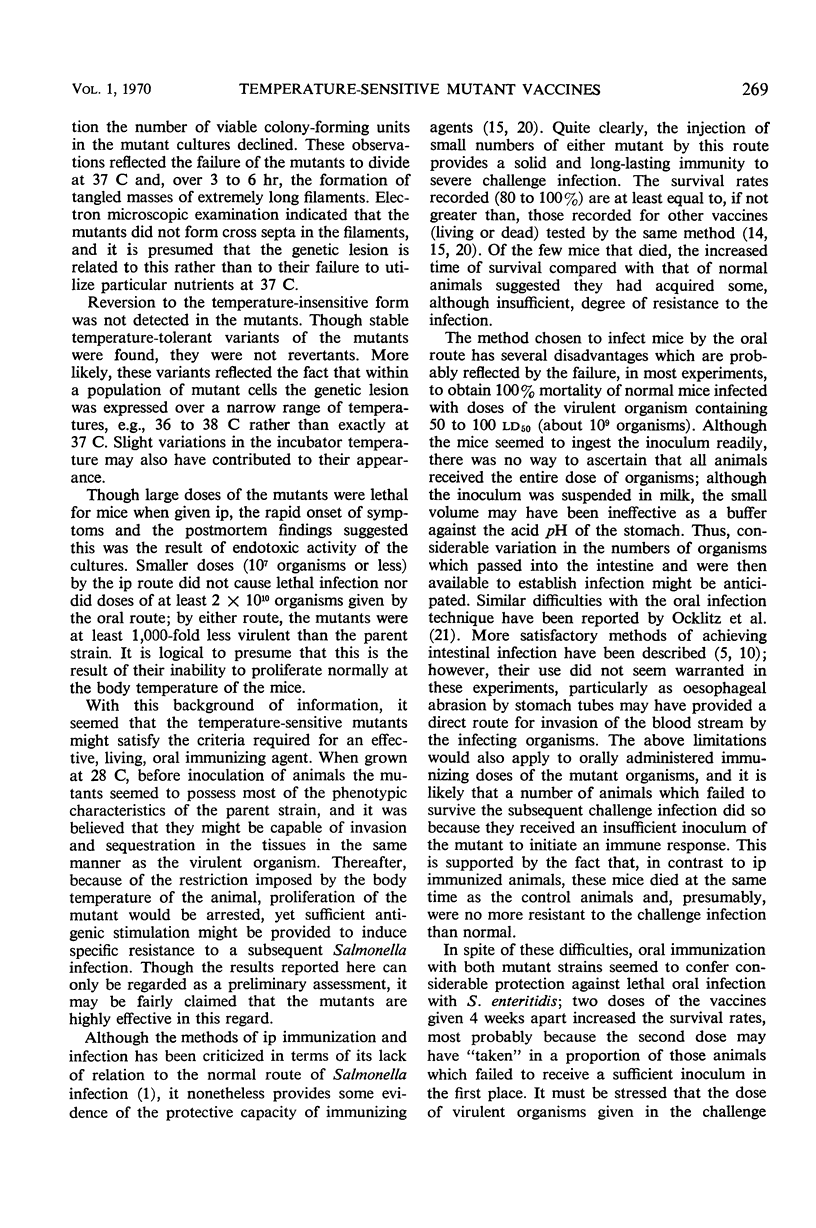Abstract
Mutant strains of Salmonella enteritidis were selected for their inability to proliferate at 37 C; when exposed to this temperature, these organisms formed tangled masses of long filaments in liquid media, presumably as a result of their inability to form cross septa. The mutants were also incapable of synthesizing flagella protein. A study of the biological charateristics of the mutants indicated that in most respects they resembled the parent strain of S. enteritidis; however, they were avirulent for mice, presumably because of the restriction of growth imposed by the body temperature of the animal. Preliminary studies have suggested that these mutants are highly effective in inducing protection against severe challenge infections of S. enteritidis; of especial interest is the fact that, when given orally, the mutants conferred a substantial degree of protection against oral infection with the virulent strain.
Full text
PDF







Selected References
These references are in PubMed. This may not be the complete list of references from this article.
- AKIYAMA T., MAEDA K., USHIBA D. [Studies on immunity in experimental typhoid. Challenge of mice passively immunized with antiserum through various routes (mechanism of immunization with killed vaccines)]. Nihon Saikingaku Zasshi. 1962 Oct;17:829–834. [PubMed] [Google Scholar]
- BLENDEN D. C., GOLDBERG H. S. SILVER IMPREGNATION STAIN FOR LEPTOSPIRA AND FLAGELLA. J Bacteriol. 1965 Mar;89:899–900. doi: 10.1128/jb.89.3.899-900.1965. [DOI] [PMC free article] [PubMed] [Google Scholar]
- Blanden R. V., Mackaness G. B., Collins F. M. Mechanisms of acquired resistance in mouse typhoid. J Exp Med. 1966 Oct 1;124(4):585–600. doi: 10.1084/jem.124.4.585. [DOI] [PMC free article] [PubMed] [Google Scholar]
- COOPER G. N. Experimental shigellosis in mice. I. Chronic infection with Shigella dysenteriae type 2. Aust J Exp Biol Med Sci. 1959 Jun;37:193–200. doi: 10.1038/icb.1959.21. [DOI] [PubMed] [Google Scholar]
- CVJETANOVIC B., UEMURA K. THE PRESENT STATUS OF FIELD AND LABORATORY STUDIES OF TYPHOID AND PARATYPHOID VACCINES WITH SPECIAL REFERENCE TO STUDIES SPONSORED BY WORLD HEALTH ORGANIZATION. Bull World Health Organ. 1965;32:29–36. [PMC free article] [PubMed] [Google Scholar]
- Collins F. M., Mackaness G. B., Blanden R. V. Infection-immunity in experimental salmonellosis. J Exp Med. 1966 Oct 1;124(4):601–619. doi: 10.1084/jem.124.4.601. [DOI] [PMC free article] [PubMed] [Google Scholar]
- EDSALL G., GAINES S., LANDY M., TIGERTT W. D., SPRINZ H., TRAPANI R. J., MANDEL A. D., BENENSON A. S. Studies on infection and immunity in experimental typhoid fever. I. Typhoid fever in chimpanzees orally infected with Salmonella typhosa. J Exp Med. 1960 Jul 1;112:143–166. doi: 10.1084/jem.112.1.143. [DOI] [PMC free article] [PubMed] [Google Scholar]
- EDWARDS W. M., CRONE R. I., HARRIS J. F. Outbreak of typhoid fever in previously immunized persons traced to a common carrier. N Engl J Med. 1962 Oct 11;267:742–751. doi: 10.1056/NEJM196210112671502. [DOI] [PubMed] [Google Scholar]
- FRETER R. The fatal enteric cholera infection in the guinea pig, achieved by inhibition of normal enteric flora. J Infect Dis. 1955 Jul-Aug;97(1):57–65. doi: 10.1093/infdis/97.1.57. [DOI] [PubMed] [Google Scholar]
- HOBSON D. Resistance to reinfection in experimental mouse typhoid. J Hyg (Lond) 1957 Sep;55(3):334–343. doi: 10.1017/s0022172400037244. [DOI] [PMC free article] [PubMed] [Google Scholar]
- Hornick R. B., Woodward T. E., McCrumb F. R., Snyder M. J., Dawkins A. T., Bulkeley J. T., De la Macorra F., Corozza F. A. Study of induced typhoid fever in man. I. Evaluation of vaccine effectiveness. Trans Assoc Am Physicians. 1966;79:361–367. [PubMed] [Google Scholar]
- JENKIN C. R., ROWLEY D., AUZINS I. THE BASIS FOR IMMUNITY TO MOUSE TYPHOID. I. THE CARRIER STATE. Aust J Exp Biol Med Sci. 1964 Apr;42:215–228. doi: 10.1038/icb.1964.23. [DOI] [PubMed] [Google Scholar]
- JENKIN C. R., ROWLEY D. BASIS FOR IMMUNITY TO TYPHOID IN MICE AND THE QUESTION OF "CELLULAR IMMUNITY". Bacteriol Rev. 1963 Dec;27:391–404. doi: 10.1128/br.27.4.391-404.1963. [DOI] [PMC free article] [PubMed] [Google Scholar]
- Kenny K., Herzberg M. Antibody response and protection induced by immunization with smooth and rough strains in experimental salmonellosis. J Bacteriol. 1968 Feb;95(2):406–417. doi: 10.1128/jb.95.2.406-417.1968. [DOI] [PMC free article] [PubMed] [Google Scholar]
- MILLER W. S., CLARK D. L., DIERKHISING O. C. A laboratory comparison of United States and British army typhoid-paratyphoid vaccine. Am J Trop Med Hyg. 1951 Sep;31(5):535–551. doi: 10.4269/ajtmh.1951.s1-31.535. [DOI] [PubMed] [Google Scholar]
- MITSUHASHI S., KAWAKAMI M., YAMAGUCHI Y., NAGAI M. Studies on the experimental typhoid. 1. A comparative study of living and killed vaccines against the infection of mice with S. enteritidis. Jpn J Exp Med. 1958 Aug;28(4):249–258. [PubMed] [Google Scholar]
- Ocklitz H. W., Mochmann H., Schmidt E. F., Hering L. Oral immunization of mice with a soluble protective antigen obtained from enteropathogenic serotypes of Escherichia coli. Nature. 1967 Jun 3;214(5092):1053–1054. doi: 10.1038/2141053a0. [DOI] [PubMed] [Google Scholar]
- VAN DE PUTTE P., VAN DILLEWIJN, ROERSCH A. THE SELECTION OF MUTANTS OF ESCHERICHIA COLI WITH IMPAIRED CELL DIVISION AT ELEVATED TEMPERATURE. Mutat Res. 1964 Jul;106:121–128. doi: 10.1016/0027-5107(64)90014-4. [DOI] [PubMed] [Google Scholar]


